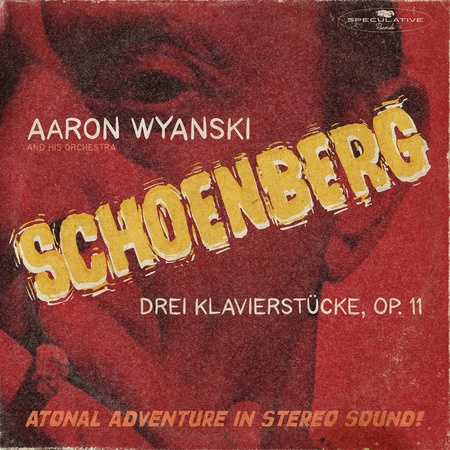
SCHOENBERG: Drei Klavierstücke, Op. 11” has been described as a set of compositions for solo piano, written by Austrian composer Arnold Schoenberg way back in 1909. Aaron Wyanski’s take on Schoenberg’s music, however, is far different from their original piano-only presentations. Wyanski’s interpretations reflect some of the sounds of early stereo music creators, like Martin Denny, Sun Ra and Esquivel. While expansive though, Wyanski’s full-group presentation here is no less challenging than the original recordings.
https://aaronwyanski.bandcamp.com/album/schoenberg-drei-klavierst-cke-op-11
For example, “Bewegte” sounds a little like that spooky music you often heard during The Twilight Zone episodes. This music is just as imaginative as Rod Serling’s TV program, too. It is strange, often jarring and altogether out of the ordinary. There’s plenty going on during this track. Instruments were seemingly chosen for the sounds they added to the overall mix, rather than to help create the collective sound for the arrangement. It has distinctly jazz moments, even though it doesn’t sound – especially with its unique instrumentation – like any jazz you’ve likely heard before.
Another, titled “Mäßige,” sounds like free jazz in places, but more traditional vibraphone-driven jazz in other spots. It also has a horn section playing off kilter sounds. Rhythm on this one is a widely shifting thing, which never seems to settle into a consistent groove. Duke Ellington once said in song that it don’t mean a thing if it ain’t got that swing. Well, this doesn’t exactly have that swing. Nevertheless, it still works in its own herky-jerky way.
“Sehr langsam” is the quietest of these three tracks. It also has what sounds like a walking bass line, which supports varying chime-y electric guitar parts and unison horn sounds. It comes off sounding like a wannabe jazz ballad, which is somehow trapped in a film noir. The Theremin that comes in and out of the piece only adds to the track’s overall sci-fi spookiness. At nearly half the way through, there is some orchestration that also enters and exits. Unlike much of the rest of this project, there is a steady rhythm part that comes and goes as it pleases here. Giving the recording an additional kitsch quotient, one can sometimes also hear bongos being played briefly. Also, during the piece’s second half, one hears what sounds a whole lot like a jazzy trumpet solo.
Schoenberg music requires concentrated listening. These aren’t toe-tapping sounds to put on in the background. Schoenberg was a contemporary of Kandinsky, a pioneer of abstraction in western art, and you can also say Schoenberg created similar abstraction with his unique music. We lost Schoenberg in 1951, which means he created his groundbreaking music even before the advent of the rock & roll era. Thus, it’s easy to understand why Schoenberg is such a big influencer on artists and teachers, both of which Wyanski is.
For comparison’s sake, it’s suggested that you also listen to Schoenberg’s originals for this work. If you do, you’ll get an idea of how much inventiveness went into Aaron Wyanski’s orchestrated recordings. This music may not be for everybody, but every self-respecting music fan ought to at least be aware of it. It is some of the most creative music in western world history.
-Dan MacIntosh
